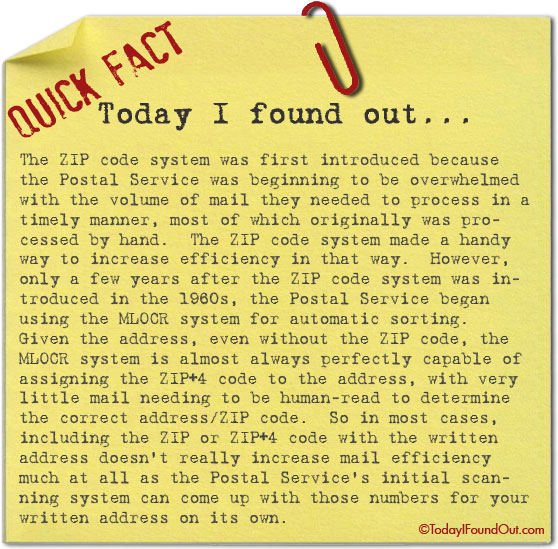The Zip Code System is No Longer Strictly Necessary
##EMBED##
Click Here for Sources and to Learn What the Numbers in the Zip Code Signify
Text Version
The ZIP code system was first introduced because the Postal Service was beginning to be overwhelmed with the volume of mail they needed to process in a timely manner, most of which originally were processed by hand. The ZIP code system made a handy way to increase efficiency in that way. However, only a few years after the ZIP code system was introduced in the 1960s, the Postal Service began using the MLOCR system for automatic sorting. Given the address, even without the ZIP code, the MLOCR system is almost always perfectly capable of assigning the ZIP+4 code to the address, with very little mail needing to be human-read to determine the correct address/ZIP code. So in most cases, including the ZIP or ZIP+4 code with the written address doesn’t really increase mail efficiency much at all as the Postal Service’s initial scanning system can come up with those numbers for your written address on its own.
| Share the Knowledge! |
|






Wrong. ZIP codes are federal districts. By using one you subject yourself to the jurisdiction of the District of Columbia.
@Cedrick That’s absurd and meaningless. They relate to postal sorting stations and, in fact, the +4 takes it down to individual P.O. box. Using your erroneous rationale if I used a German postal code I would be subjecting myself to Berlin. In any case it’s no longer necessary to put zip codes on mail as all addresses are read mechanically and assigned the appropriate zip code via OCR. Faster and more error-free.
” A ZIP+4 Code uses the basic five-digit code plus four additional digits to identify a geographic segment within the five-digit delivery area, such as a city block, a group of apartments, an individual high-volume receiver of mail, a post office box, or any other unit that could use an extra identifier to aid in efficient mail sorting and delivery. However, initial attempts to promote universal use of the new format met with public resistance and today the plus-four code is not required.[7] In general, mail is read by a multiline optical character reader (MLOCR) that almost instantly determines the correct ZIP+4 Code from the address—along with the even more specific delivery point—and sprays an Intelligent Mail barcode (IM) on the face of the mail piece that corresponds to 11 digits—nine for the ZIP+4 Code and two for the delivery point. “
Most importantly (and overlooked), is that a ZIP Code is not required for single-piece price First-Class Mail (including Priority Mail) per Section 602.1.3.e.2 of the 2018 USPS Domestic Mail Manual.
The USPS launched the ZIP+4 initiative in 1983. It is interesting to note that 35 years later that the staff for congressional offices (both houses) have still not managed to learn how to use it.